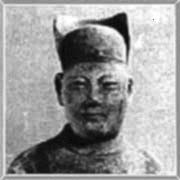Today, paper seems ordinary to us. We crumple it in our hands and throw it away without a second thought, unaware that it has come a long way over three thousand years, from the first marks and drawings made in caves and on clay, to the rudimentary forms of paper developed two thousand years ago, evolving into the refined product we use today.
Archaeological discoveries in China, combined with radiocarbon dating, demonstrate that paper existed two centuries before Ts’ai Lun. However, Ts’ai Lun is still credited as the inventor of the paper we know today.
|
|
|
Ts’ai Lun |
1. Ts’ai Lun: In 105 AD, during the Han Dynasty under Emperor He, Ts’ai Lun presented several sheets of paper to the emperor, who was pleased and awarded him a noble title, appointing him to court. As a eunuch responsible for managing the court’s wealth, he became wealthy through his invention of paper. However, he later fell victim to palace intrigue and lost favor with the emperor. In desperation, he bathed, dressed in fine clothes, consumed poison, and lay down to die.
Ts’ai Lun’s Paper-Making Process:
Ts’ai Lun used the inner bark of the mulberry tree and bamboo fibers, mixing them with water and pounding them with a wooden tool. He then poured the mixture onto a flat cloth, spreading it thinly and allowing it to dry. Once dry, he discovered that it was easy to write on and lightweight. This method of paper-making was first used in China and then spread to Korea, Samarkand, Baghdad, and Damascus.
Although Ts’ai Lun invented paper early on, it took thousands of years before paper production became widespread throughout Europe and Asia.
2. Countries and the Invention of Paper:
Around 400 AD, people in India began making paper.
About 500 years later, the Abbasid Caliphate started using paper.
Muslims adopted paper very early, from India to Spain, while Christians continued to use parchment.
 The influence of Arabs spread from Africa to the Mediterranean. Around 650 AD, the Arabs invaded Sicily and then moved into Morocco. These two cities later became cultural centers for Arabs, spreading their traditions and beliefs. In the following centuries, the Arab territories expanded, including advanced countries like Algeria, Tunisia, and Libya, along with vast territories in Spain, Portugal, and Italy.
The influence of Arabs spread from Africa to the Mediterranean. Around 650 AD, the Arabs invaded Sicily and then moved into Morocco. These two cities later became cultural centers for Arabs, spreading their traditions and beliefs. In the following centuries, the Arab territories expanded, including advanced countries like Algeria, Tunisia, and Libya, along with vast territories in Spain, Portugal, and Italy.
In 751 AD, Arabs living in Samarkand, Kazakhstan—about 800 km from the Chinese border—faced an attack by the Chinese army. Not only did they repel the attack, but they also pursued the Chinese forces. The Arabs captured Chinese prisoners who knew the paper-making technique. In exchange for their freedom, the Chinese shared their knowledge of paper-making, which quickly spread among the Arabs. By the 10th century, Arabs were using cotton to make thinner, higher-quality paper.
Around 1100 AD, Italy and Spain expelled the Arabs, but the paper industry remained strong. In Italy, the oldest document written on ancient paper was presented to King Roger of Sicily, dated 1102.
In the early 1200s, Spanish Christians learned paper-making from Muslims, and by 1250, Italians began producing paper and selling it throughout Europe.
In 1338, French clergy began making paper. It wasn’t until 1411—fifteen centuries after Ts’ai Lun’s invention—that Germans began paper production. Especially after 1450, when Johannes Gutenberg developed the printing press, parchment and vellum became obsolete. Cheaper and more uniform, paper became essential for mass production, which animal hide could not meet.
3. Comparing the Inventions of Ts’ai Lun and Gutenberg
|
|
|
Gutenberg |
In China, before Ts’ai Lun, most writing materials were made of bamboo, which were heavy and cumbersome. Some books were written on silk, but this was too expensive. In the West, before the advent of paper, books were written on parchment made from sheep or calf skin. Later, papyrus became favored by the Greeks, Romans, and Egyptians. However, both parchment and papyrus were costly. Modern books and documents made from paper are affordable and plentiful, thanks to the existence of paper. In fact, without the printing industry, paper might not hold the significance it does today. So, who is more important, Ts’ai Lun or Gutenberg? Ultimately, Ts’ai Lun is arguably more significant because, besides writing, paper is used for many other purposes. Moreover, without paper, Gutenberg may not have conceived the idea of the printing press. If only one of these inventions had occurred, it’s likely that people would have used block printing (which predates Gutenberg’s invention) on paper rather than movable type on parchment.
4. Comparing Chinese and Western Civilizations
The inventions of Ts’ai Lun and Gutenberg are indeed two of the ten greatest inventions in history. To illustrate the significance of paper and printing, we must consider the cultural developments in China and Western countries. In the second century, Chinese civilization lagged behind Western nations. In the following thousand years, Chinese technology surpassed that of Western nations, and for about 7-8 centuries, Chinese civilization was regarded as the standard for advanced countries worldwide. Certainly, papyrus scrolls were superior to books made from bamboo or wood. This reality hindered the development of Chinese civilization before the invention of paper. Imagine a Chinese student having to carry a cumbersome “mountain” of bamboo books. Completing administrative tasks was also a challenge for the government. Therefore, after the invention of paper, Chinese civilization advanced rapidly, surpassing Western nations within five centuries. Naturally, the fragmentation of Western countries also contributed to their lag behind China. Marco Polo confirmed that even in the 13th century, China was much more prosperous than Europe. But why did they eventually fall behind Europe? There are complex cultural explanations, but perhaps the simplest reason is that from the 15th century onward, Europe had the genius of Gutenberg, who developed large-scale printing technology. This led to rapid cultural advancement in Europe. Meanwhile, China did not have a figure like Gutenberg and continued to use block printing, resulting in a slower cultural development.
By the 1800s, handmade paper was made from a mix of hemp, cotton, flax, and various other plants. At that time, Louis Robert, an employee of a local paper company in Essonne, south of Paris, invented a paper machine capable of mass-producing paper. This innovation made paper cheaper, and surplus paper was rolled and stored. With this invention, long-fibered plant pulp became essential for paper production.
Fifty years later, wood pulp became regularly used for paper-making.
The printing industry began to expand rapidly, with books and important documents being produced quickly. This mass-printing method led to a significant demand for paper.



















































